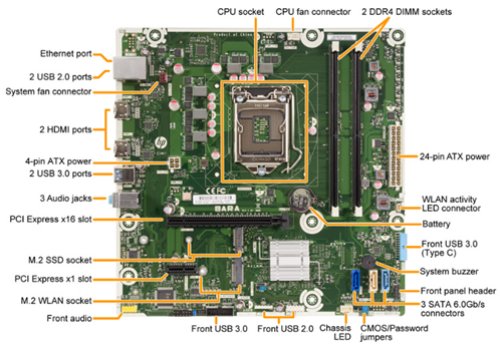Main Board Expansion Slots
It has everything that a high-end board should have, such as multiple USB ports, including two Thunderbolt 3 ports, three PCIe 3.0 x16 slots and one PCIe 3.0 x1 slot, excellent storage capacity, with three M.2 slots and six SATA ports, and so on. The motherboard is considered the nervous system of a computer. Everything that is not built into the motherboard is connected to it in slots or through ports. Its main components are the system clock, CPU, chipset, RAM, ROM BIOS, CMOS, power supply, ports, and the system bus with expansion slots.

An expansion card is an electronic circuit board that adds more functionality to a desktop computer. These cards are installed into the expansion slot of a computer motherboard, and they allow the computer to perform additional functions not offered by the motherboard. Video cards and sound cards are common examples: a new video card added will enhance the three dimensional graphics processing power of a computer while a new sound card may improve a computer’s audio input.
There are alternative terms used for this type of card, and it is also known as expansion board, add-on card, interface adapter or an internal card. Generally, between one and seven expansion cards can be installed into the desktop computer system. Laptops do not use standard cards due to their small form factor, although they can often accept a removable PCMCIA card that offers additional functions.
The Altair 8800, developed in the mid 1970s, was the first microcomputer to add an expansion card bus. In 1981, IBM® launched its first PC with an XT bus, which was later replaced with a 16-bit ISA. The introduction of the PCI bus in 1991 resulted in modern forms of interface adapters that provided additional benefits beyond enhanced graphics and sound.


Most cards are inserted in PCI or “Peripheral Component Interconnect” slots, which are integrated circuits fitted onto the motherboard. One edge of the card holding the contacts or keys is inserted into the slot. This establishes an electrical contact between the motherboard and the card’s integrated circuits.

Main Board Expansion Slots Games
:max_bytes(150000):strip_icc()/gig-57c732ed3df78c71b60e7aa5.jpg)
Standard interface adapters, such as graphics cards and sound cards, offer various added functions. Some video cards offer video capture, MPEG 2 and MPEG 4 decoding, a light pen, and the ability to connect to multiple monitors, for example. Sound cards may add functions for composing music, editing audio presentations, and other multimedia applications.
Main Board Expansion Slots Game
There are some “low-profile” cards that fit in a lower height computer framework. Some are used solely for external connectivity such as modem cards, storage area network (SAN), and network cards, which are commonly referred to as I/O cards or input/output cards. A USB card is mainly used by users who need additional USB or Firewire ports.
A PC expansion card can only be inserted on computers with available expansion slots. Computers such as the Apple Macintosh® and other all-in-one systems do not accept these cards.